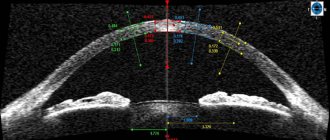Antiseptic eye drops are used for many ophthalmological diseases that are accompanied by inflammation and the proliferation of pathogens. An infectious inflammatory process in the eye area can be caused by 3 types of microbes: viruses, bacteria and fungi. Depending on the pathogen, the optimal treatment is selected for the patient, since a certain drug may have antiviral activity, but not have any effect on bacteria and fungi (or vice versa). The task of local antiseptics is to stop the growth and reproduction of pathogenic microorganisms, thereby accelerating the process of healing and restoration of eye tissue.
Types of medicines
Among the wide range of antiseptic drops, we can roughly distinguish 2 types:
- broad-spectrum antiseptics;
- antibacterial agents.
Broad-spectrum antiseptics have antibacterial, antiviral and antifungal properties. Some of them even affect those types of bacteria that have developed resistance to antibiotics. They are prescribed for bacterial and viral conjunctivitis, keratitis and inflammation of unknown etiology. Fungal eye infections are extremely rare, although there are keratitis that are caused by this particular microflora. Broad-spectrum antiseptics are used in this case as part of complex therapy, since such diseases are usually treated systemically and for a long time.
Antibacterial eye drops are antibiotics for topical use in ophthalmology. They differ in their spectrum of activity, structure and chemical properties. They are used when the doctor is absolutely sure that the infectious eye disease is caused only by bacterial microflora.
Antibiotic eye drops for conjunctivitis
Absolutely all antibiotic eye drops have conjunctivitis indicated for use. For purulent or purulent-mucous discharge from the eyes, any of the broad-spectrum antibiotics are usually prescribed: Floxal, Vigamox, Normax.
If the drug is ineffective for 5 days, it is recommended to stop the drug for a day, and in the morning before washing, take a smear from the conjunctival sac to determine sensitivity to antibiotics. Recently, epidermal staphylococcus or fecal enterococcus, which have multiresistance to a large number of antibacterial drugs (rarely resistance to moxifloxacin and tetracycline), are most often cultured from smears.
Okomistin
Okomistin drops and its analogues contain the disinfectant miramistin. This product is a broad-spectrum antiseptic that inhibits the vital activity of most pathogenic microbes. The concentration of the active substance in eye drops is 0.01%. The medicine is used for viral, fungal and bacterial conjunctivitis, blepharitis and keratitis. This antiseptic is also prescribed for eye injuries and burns as part of complex therapy.
The medicine is instilled 1-2 drops into each eye up to 6 times a day. The optimal treatment regimen should be selected by an ophthalmologist, based on the characteristics of the patient’s body and the severity of the symptoms of the disease. This drug can be used to treat all age categories of patients, including infants. The use of Okomistin is permitted for pregnant and lactating women, since the drug practically does not enter the systemic bloodstream. The only contraindication is individual intolerance to miramistin or other components in the drops.
Under the influence of the antiseptic Okomistin, the sensitivity of bacteria to antibiotics is reduced, therefore in complex clinical cases they are used together
How else are eye diseases treated?
Allergies
If the nature of the disease is allergic, then drops with azelastine (allergodil) and olopatadine (opatanol) act quickly and efficiently. They are allowed for children from three years of age, nursing mothers and pregnant women. It is effective against inflammation during the flowering period of plants, and also has an immunostimulating and immunomodulating effect of allergoferon-beta.
Viruses
For viral infections, interferon-based drops are used, for example, ophthalmoferon.
Aktipol with aminobenzoic acid, in addition to its antiviral effect, has an anti-inflammatory, regenerating and healing effect. It is good to use for viral diseases and after physical injuries and surgical interventions.
Bacteria
Okomistin drops almost always help (this is an analogue of the widely known Miramistin). Okomistin fights bacteria, viruses, fungi and protozoa, does not cause discomfort when instilled and has almost no contraindications. It is approved for use by children over three years of age, and in cases of urgent need can be used by pregnant and lactating women.
If the nature of the disease is not bacterial, eye drops should first be chosen without antibiotics. Antibacterial drugs are prescribed in the presence of purulent (bacterial) inflammation.
A drug based on indomethacin, Indocollir, helps well with postoperative inflammation and relieves pain.
A number of highly effective drops are produced based on dexamethasone:
- dexamethasone itself (including with the prefixes Bufus, Betalek, Lance, Mez),
- dexamethasonelong;
- dexapose (also has an antihistamine effect);
- dexoftan (hydroxypropyl methylcellulose in the composition moisturizes the eyeball, and benzalkonium chloride has antiprotozoal and antifungal effects);
- oftan.
Drops of taufon and taurine are produced with taurine (with the prefixes dia, bufus, SOLOpharm, akos). They stimulate regeneration processes and are indicated for injuries, as well as in combination with other drugs for ulcerative lesions, microcracks and other eye injuries.
An excellent antimicrobial agent is sulfacetamide. It is not aggressive, unlike antibiotics, and is approved for use in children and adults in drops. The following drugs are produced with it: sodium sulfacyl with the prefixes dual, dia, mez. Sulfacetamide was formerly called albucid and was widely used in ophthalmic practice.
In advanced cases, surgical intervention is performed, especially when there is no sufficient outflow of pus and the question is about preserving not only vision, but also the eye.
Purulent-inflammatory forms require more serious therapy with antibiotics. They are used in the form of eye drops. In severe cases or with large areas of damage, antibiotic injections and oral antibacterial agents are prescribed.
"Artificial tear"
When treating with any drugs, it is also necessary to use drops with hypromellose - “artificial tears” - to soften and moisturize: pilocarpine, lacrisify, slezin. This reduces the feeling of grit, dryness and itching. For the same purposes, as well as to relieve minor swelling and eliminate irritation, drops with tetrizoline are recommended: visine, octylia, montevisine. Tetrizoline is also effective for mild allergies.
According to indications, regenerating ointment with vitamin A - VitA POS can be used.
Albucid
"Albucid" is an antimicrobial agent that has a bacteriostatic effect. This means that the medicine does not kill microbes, but only inhibits their vital activity, making it impossible for them to function and reproduce normally. Due to this effect, it becomes easier for the body to fight infection, and the local immunity of the mucous membrane of the eye is activated.
The active ingredient of Albucid is sulfacetamide. It blocks the production of vital substances in bacteria, causing them to become inactive and stop dividing. "Albucid" is active against Escherichia coli, gonococci, streptococci, chlamydia and staphylococci. It is important to remember that this substance does not affect viruses and fungi in any way, so it can only be used to treat patients with a bacterial infection.
Indications for use:
- purulent conjunctivitis;
- blepharitis;
- corneal ulcers with purulent discharge.
"Albucid" is instilled 2 drops into each eye approximately 4-6 times a day. When the medicine gets on the mucous membrane, the patient may feel a strong burning sensation and discomfort, and also complain of increased lacrimation. Due to this side effect, it is better not to use the medicine for the treatment of young children, giving preference to other, “milder” drugs, although formally the drug is not contraindicated for children and can be used at any age.
Indications for use
Eye drops from the clinical-pharmacological group of antibiotics are prescribed to patients with bacterial infections. They are also used for mixed pathologies. The drugs are in demand in the treatment of bacterial-viral or bacterial-fungal infections. Local remedies are included in therapeutic regimens when diagnosing the following diseases in adults and children:
- conjunctivitis - inflammatory lesions of the mucous membrane covering the inner surface of the eyelids and sclera;
- keratitis - inflammatory pathologies of the cornea, causing clouding and decreased vision;
- blepharitis - bilateral recurrent inflammation of the ciliary edge of the eyelids;
- iridocyclitis - combined lesions affecting the iris and ciliary body of the eye;
- dacryocystitis - inflammatory processes in the lacrimal sac, developing against the background of obliteration or stenosis of the nasolacrimal duct.
Ophthalmic agents are used to eliminate all signs of infectious and inflammatory pathology. They cope well with redness of the conjunctiva, pain, pain, swelling of the eyelids, purulent or mucous discharge from the eyes.
Antibiotic eye drops cannot be used in the treatment of inflammatory diseases caused by the introduction of infectious pathogens of fungal and viral origin. After removing the foreign object from the cornea, more gentle means are prescribed. During the period of bearing a child or breastfeeding, the drugs are prohibited or are used after comparing their benefits to the woman and the risk of disrupting the intrauterine development of the fetus.
Eye drops with an antibiotic are prescribed in case of development of infectious abnormalities of the visual organs. Symptoms of such ailments include the following:
- Mucous or purulent secretion from the eyes;
- Deterioration of visual functions;
- Conjunctival hyperemia;
- The appearance of increased sensitivity to light;
- Itching and burning sensation.
When such manifestations appear, an examination is recommended to help detect the pathogenic microflora that caused the disease. According to research data, the following bacterial anomalies can be identified:
- Dacryocystitis. This term refers to blockage of the tear ducts. The disease often occurs in newborn babies, but sometimes it is detected in adults. When obstruction of this fragment of the visual organ occurs, the patient experiences discomfort in the eyes - burning, pain. Conjunctival hyperemia and swelling in the eye area are often observed;
- Keratitis. In this case, we are talking about an inflammatory lesion of the cornea, which can have a different nature. The person experiences pain and clouding of the affected area. The disease can be independent or be one of the signs of infections;
- Barley. With its development, a person develops purulent formations on the extreme part of the eyelids. The damaged areas become inflamed, swelling and redness are observed;
- Infectious conjunctivitis. This is the most common lesion of the conjunctival membrane. It can occur at different ages and is caused by violation of personal hygiene rules. Also, the problem is often associated with the activity of bacteria against the background of a weakened immune system;
- Creeping corneal ulcer. This disorder is associated with microtraumas of the eyeball. A common cause of the abnormality is streptococcus. It is sensitive to a wide variety of antibiotics;
- Blepharitis. This inflammation affects the eyelids and may be bacterial in nature. With the anomaly, purulent discharge is observed, which leads to gluing of the eyelids. This resembles the course of conjunctivitis.
Antibacterial drops are used for various infections. Most often, injuries lead to the development of ailments - they can be of a domestic nature or arise as a result of surgical interventions on the eyes.
At the early stage of infectious pathology and in simple cases of its occurrence, antibiotics are replaced with bacteriostatic drugs. In this situation, you can use Albucid or Vitabact.
Such products do not kill bacterial microorganisms, but stop their development. This allows the body to cope with the infection on its own. If severe pain in the eyes and blurred vision occurs, you should stop using the drops.
Tobramycin
Eye drops with the antibiotic tobramycin are widely used for the treatment and prevention of infectious eye diseases. The most well-known trade names of drugs with this active ingredient are “Tobradex” and “Tobrex”. This antibiotic has a wide spectrum of action; it is active against staphylococci, some streptococci, Escherichia coli and Pseudomonas aeruginosa, chlamydia, gonococci and enterobacteria.
Indications for use:
- bacterial blepharitis;
- bacterial conjunctivitis;
- keratoconjunctivitis;
- keratitis;
- recovery period after eye surgery to prevent the development of bacterial infection.
The medicine is instilled 1-2 drops into each eye, the frequency of procedures during the day is determined by the attending physician. Sometimes in the acute period, frequent administration of the drug may be necessary (approximately every hour). On average, it is recommended to instill the medicine every 4 hours. Tobramycin, like other antibiotics, is inactive against viral and fungal infections. If the inflammation is of this nature, then drops with this substance can be prescribed only to prevent the addition of bacterial microflora.
Tobramycin is used to prevent infectious eye diseases even in newborns
Causes and types of conjunctivitis in adults and children
The main causes of conjunctivitis:
- neglect of personal hygiene;
- hypothermia of the eyes;
- weak immunity;
- metabolic disorders;
- diseases of the nasopharynx (especially chronic ones).
People with vision problems are also at risk: myopia, astigmatism, farsightedness. Often conjunctivitis occurs due to a lack of vitamins.
There are several types of the disease:
- Viral conjunctivitis. Transmitted by airborne droplets, external manifestations are similar to a cold. It is highly contagious; during treatment it is not recommended to contact other people.
- Bacterial conjunctivitis. Similar to viral, but caused by bacteria. Treated with antibiotics.
- Allergic conjunctivitis, most often seasonal inflammation of the eyes from a reaction to any allergen.
- Fungal (ophthalmomycosis) conjunctivitis is caused by a fungal infection entering the mucous membrane of the eye.
Each of the varieties has an incubation phase of 3-4 days, which later becomes acute, with inflammation of the eye, fever and headache.
Conjunctivitis manifests itself as discharge of pus, dry eye, sensation of a foreign body in the eye, swelling and redness of the sclera. Sometimes you may feel itching and burning.
Ofloxacin
Floxal is an eye drop containing ofloxacin. It belongs to the fluoroquinolone group of antibiotics and is active against a large number of bacterial species. Ofloxacin inhibits the growth and activity of staphylococci, Klebsiella, gonococci, Shigella, streptococci, Haemophilus influenzae, etc. Due to such a wide range of influence, it can be used in cases where it is impossible to accurately determine the bacterial pathogen.
Indications for use of "Floxal":
- barley;
- conjunctivitis;
- blepharitis;
- dacryocystitis;
- ulcers on the surface of the cornea;
- rehabilitation after ophthalmological operations.
The medicine is instilled 1-2 drops 2-4 times a day, depending on the severity of the disease. The course of treatment should not exceed 14 days, as bacteria may develop resistance to these antimicrobial drops.
"Vitabakt"
The main active ingredient of Vitabact ophthalmic drops is piloxidin. It belongs to the antimicrobial substances of the biguanide group. These drops are a broad-spectrum antiseptic, as they affect not only pathogenic bacteria, but also some viruses and fungi.
Indications for use:
- inflammatory processes of the conjunctiva;
- keratitis;
- dacryocystitis;
- prevention of infectious diseases of the anterior part of the eye during the rehabilitation period after eye surgery.
The frequency and duration of treatment is determined by the ophthalmologist, taking into account the characteristics of the disease. On average, it is recommended to instill the medicine 2 drops 2-6 times a day. To prevent complications, it is used 1-2 times a day. The course of treatment should not exceed 10 days.
Drops may temporarily reduce visual acuity, which returns to normal after stopping treatment with the drug. As a rule, this phenomenon is not a reason to discontinue the drug, but if it occurs, you must inform your ophthalmologist about it.
Causes of eye infection
Infectious processes are provoked by bacteria, herpes virus, other viruses (adenovirus, enterovirus), chlamydia, fungi (usually staphylococci and streptococci).
The causes of eye disease are:
- entry of a foreign body into the organ of vision;
- consequences of surgical intervention;
- injury, blow;
- reduced immunity;
- allergic reaction;
- physical factors - dry air, improper use of lenses for a long time without interruption, heavy load on the visual apparatus, impaired function of the tear film;
- poor hygiene, especially when instilling other drugs, the habit of rubbing your eyes with dirty hands;
- taking drugs that suppress the immune system (immunosuppressants).
"Maxitrol"
"Maxitrol" is eye drops that contain two antibiotics and anti-inflammatory components. Indications for use are infectious diseases of the eyeball, which are caused by microorganisms sensitive to the components of the drug. Maxitrol contains 3 active ingredients:
- neomycin,
- polymyxin B,
- dexamethasone.
The first 2 components are antibiotics, the third substance is a hormone. The medicine has a bactericidal effect against Staphylococcus aureus, streptococci, Klebsiella, Enterobacteriaceae, Shigella, Haemophilus influenzae and Pseudomonas aeruginosa. Due to the dexamethasone in the drops, they exhibit a pronounced anti-inflammatory effect. They quickly eliminate swelling and redness in the conjunctiva and mucous membrane of the lower eyelids.
"Maxitrol" cannot be used for tuberculosis, fungal and viral eye infections. The side effect of this medication may be an increase in intraocular pressure, so it is prescribed with caution to patients with glaucoma and cataracts.
How to choose a medicine?
Antiseptic drops should be selected only by an ophthalmologist based on the diagnosis and severity of symptoms. It is quite difficult to independently distinguish viral conjunctivitis from bacterial conjunctivitis; in addition, many medications have their own contraindications and features of use.
Before prescribing eye drops, the ophthalmologist must examine the patient and make a diagnosis
When choosing the optimal drops for a patient, in addition to the diagnosis, the doctor must take into account:
- patient's age;
- general condition of the body and immunity;
- spectrum of action of the drug;
- compatibility of drops with other medications that a person takes;
- predicted tolerability of the drug and resistance of pathogenic microorganisms to it;
- availability of funds.
You should not self-medicate, since advanced infectious eye diseases can cause serious complications (even blindness). It is important to remember that eye drops must be individualized. They cannot be passed on for use by other people, even if we are talking about immediate relatives.
Which drops are suitable for children?
Indications for the use of antibacterial eye drops for children are similar to those for adults. Antimicrobials are also used to prevent gonoblennorrhea in newborns.
List of children's antibacterial agents:
- Albucid (Sodium Sulfacyl).
- Tobrex.
- Levomycetin.
- Tsiprolet.
- Vitabact.
- Maxitrol.
- Phloxal.
- Uniflox.
- Fucithalmic.
Self-medication during antimicrobial therapy is prohibited.
Terms of use
The effect of treatment largely depends on how correctly the drops are used. One of the main rules is maintaining cleanliness. Before and after the instillation procedure, you must wash your hands with soap to prevent the spread of infection. If the patient does not live alone, until complete recovery he needs to use an individual towel or disposable dry wipes to wipe the face and eyes. Such measures are necessary to prevent infection of his family members.
In addition, you need to remember the following recommendations:
- the bottle of drops should not touch the eyelids and conjunctiva; when instilling, it is advisable to keep the container with the medicine at a distance of at least 4–5 cm from the surface of the eye;
- before pressing the bottle, you need to look up and pull down the lower eyelid so that the drops fall into this space;
- the amount of medicine should not exceed 1–2 drops (excess will still spill out, since the capacity of the conjunctival sac is small);
- The medicine should always be injected into both eyes, even if the painful symptoms bother only one side.
After instilling the product, you can close your eyes and lie down for a while in a relaxed state. If the doctor has prescribed several types of drops, the minimum interval between the use of different medications should be 15–20 minutes.
If you have infectious eye diseases of any nature, you should not use contact lenses. Until complete recovery, patients with impaired visual acuity are better off wearing glasses. If contact lenses were worn during inflammation, they need to be replaced with new ones, as they can cause the infection to re-develop.
special instructions
When treating your eyes, do not touch your hands or eyelids with the dropper. If an allergic reaction occurs during treatment, treatment is stopped immediately. Do not exceed the duration of treatment indicated by the doctor. Otherwise, a fungal infection may develop.
If improvement is not observed within 3 days of using the drug, then it is discontinued. In this case, the doctor selects an alternative treatment.
You should not use L-Optic when wearing soft contact lenses. Before treating your eyes, they should be removed; you can put on the lenses again only after half an hour.
After eye drops, vision remains cloudy for some time. During this period, you cannot drive vehicles or work with complex mechanisms.
Pregnancy and lactation
The drug can be prescribed to pregnant women, but only if the doctor sees no alternative treatment. The medicine should not be prescribed to nursing mothers, since the mechanism of action of the active substance on patients in this group has not been studied.
Use in childhood
The instructions for use indicate that the drops are not prescribed to children under 1 year of age.
In addition, caution is required when treating children under 18 years of age with the drug.
Side effect
A side effect when using antiseptic drugs most often consists of local discomfort. If the product gets on the mucous membrane of the eye, the patient may feel a temporary burning sensation and also notice severe lacrimation. In some cases, redness and slight swelling of the conjunctiva may occur.
If, when using any drug, unpleasant symptoms cause severe discomfort, then this should be reported to the ophthalmologist immediately. The risk of developing an allergy or individual intolerance to the drug can never be excluded, even if the patient has already used this medicine before. With a wide range of modern antiseptic drops, the ophthalmologist will be able to select the optimal drug, the use of which will be effective and as comfortable as possible.
Antiseptics are often used not only in ophthalmology, but also in other areas of medicine. Inhibition of the vital activity of pathogenic microbes allows you to minimize the risk of developing severe complications of the disease, as well as speed up recovery. To select antimicrobial drops, you should always consult a doctor, since unsuccessful attempts at self-medication can distort the clinical picture and complicate making an accurate diagnosis.










